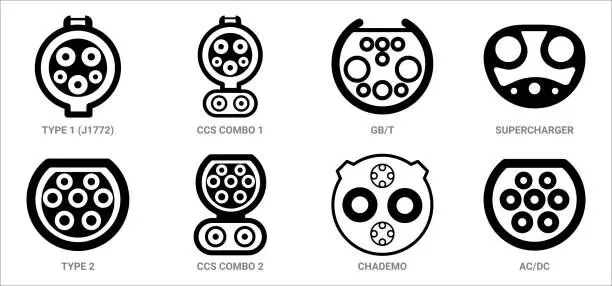Notifications

7 minutes, 32 seconds
-17 Views 0 Comments 0 Likes 0 Reviews

Understanding EV Charging Connector Types: A Comprehensive Guide
As a trusted EV charger manufacturer in China, Topper Company provides dependable electric vehicle charging station equipment and comprehensive solutions.
As electric vehicles (EVs) become increasingly popular, knowing your way around EV charging connectors is essential. Different EVs use different charging ports based on region, charging type (AC or DC), and manufacturer preferences. Whether you're charging at home, work, or on the road, understanding connector types ensures a smooth, efficient experience.
This guide breaks down the most common EV charging connectors, how they function, and what EVs they’re compatible with—helping you stay charged and confident wherever you drive.
AC (alternating current) charging is the most common and convenient method for daily use. It comes in two primary levels:
Level 1 charging uses a standard 120V household outlet—just plug in your EV with the cord that came with it. It’s the slowest method, adding about 3 to 5 miles of range per hour, making it best suited for overnight charging or low-mileage drivers.
Level 2 charging operates at 240V and provides up to 40 miles of range per hour. It requires a dedicated charging station—like a home wallbox or public charger in workplaces and parking lots. Most EV owners prefer Level 2 charging due to its balance of speed and accessibility.
Two key connector types are used for AC charging:
SAE J1772 (Type 1): The standard for non-Tesla EVs. Compatible with both Level 1 and Level 2 charging, it’s found at virtually all public stations in North America.
NACS (Tesla Connector): Tesla’s proprietary connector, supporting both AC and DC charging. Tesla is gradually opening this network to other EVs, which could broaden its adoption.
For road trips or when you're in a rush, DC fast charging is the go-to. It bypasses the car’s onboard charger and delivers electricity directly to the battery, significantly reducing charging time.
Here are the three major connector types for fast charging:
SAE Combo (CCS1): The most widely adopted in North America. It combines the J1772 AC connector with two additional pins for DC charging—supporting speeds up to 350 kW.
CHAdeMO: A Japanese standard used in older EVs (e.g., Nissan Leaf). While it supports bidirectional charging (V2G), its use is declining in favor of CCS.
NACS (Tesla Connector): Supports both AC and DC charging. Tesla’s Supercharger network is extensive and now opening up to non-Tesla EVs.
As EV ranges increase, so does the demand for faster charging. Stations offering 150 kW to 350 kW are becoming more common, capable of adding hundreds of miles of range in minutes—ideal for long-distance driving.
The Combined Charging System (CCS) has emerged as the global standard for DC charging.
CCS1: Used in North America, based on the J1772 plug.
CCS2: Used in Europe, based on the Type 2 (Mennekes) plug.
Key Benefits:
Supports both AC and DC charging via one port.
Compatible with power levels up to 350 kW.
Backed by major automakers and charging networks globally.
Despite its decline, CHAdeMO remains important for select EV models.
Notable Features:
Bidirectional Charging: Enables vehicle-to-grid (V2G) energy transfer.
Legacy Compatibility: Essential for older Japanese EVs.
Limitations:
Incompatible with CCS and GB/T without adapters.
Limited presence outside Asia.
In China, GB/T is the mandated connector for both AC and DC EV charging.
Key Features:
Supports high power levels up to 250 kW.
Widely used across Chinese-made EVs and infrastructure.
Global Impact:
As Chinese EV brands expand globally, GB/T's influence is growing, though its incompatibility with CCS and CHAdeMO may limit global reach.
Tesla's North American Charging Standard (NACS) combines sleek design and powerful capabilities.
Advantages:
Compact Size: Easier to use and install than CCS or CHAdeMO.
Dual Capability: Supports both AC and DC charging.
High Power Delivery: Up to 250 kW charging capacity.
Future Outlook: Tesla’s move to open its Supercharger network to other brands could boost NACS adoption, though its proprietary nature may pose challenges for universal use.
Understanding your EV’s charging requirements is key to hassle-free ownership. Here's a quick summary:
| Connector Type | Used For | Max Power | Used By |
|---|---|---|---|
| SAE J1772 (Type 1) | AC Level 1 & 2 | ~19.2 kW | Most North American EVs |
| CCS1 | DC Fast Charging | Up to 350 kW | North American non-Tesla EVs |
| CHAdeMO | DC Fast Charging | ~62.5 kW | Some Japanese EVs (e.g., Leaf) |
| NACS | AC + DC (proprietary) | Up to 250 kW | Tesla (and now expanding to more) |
| GB/T | AC + DC (China only) | Up to 250 kW | Chinese EVs |
The EV charging landscape is evolving rapidly, with new standards and faster technologies emerging worldwide. While regional differences still exist, the move toward global standardization—particularly with CCS and NACS—signals a more unified and efficient future.
By understanding which charging connectors suit your EV and lifestyle, you can make smarter decisions about where and how you charge, ensuring a smooth and future-ready EV experience.Know more about Google SEO Directory
China EV Chargers EV Charger Manufacturer EV Charging Solutions

